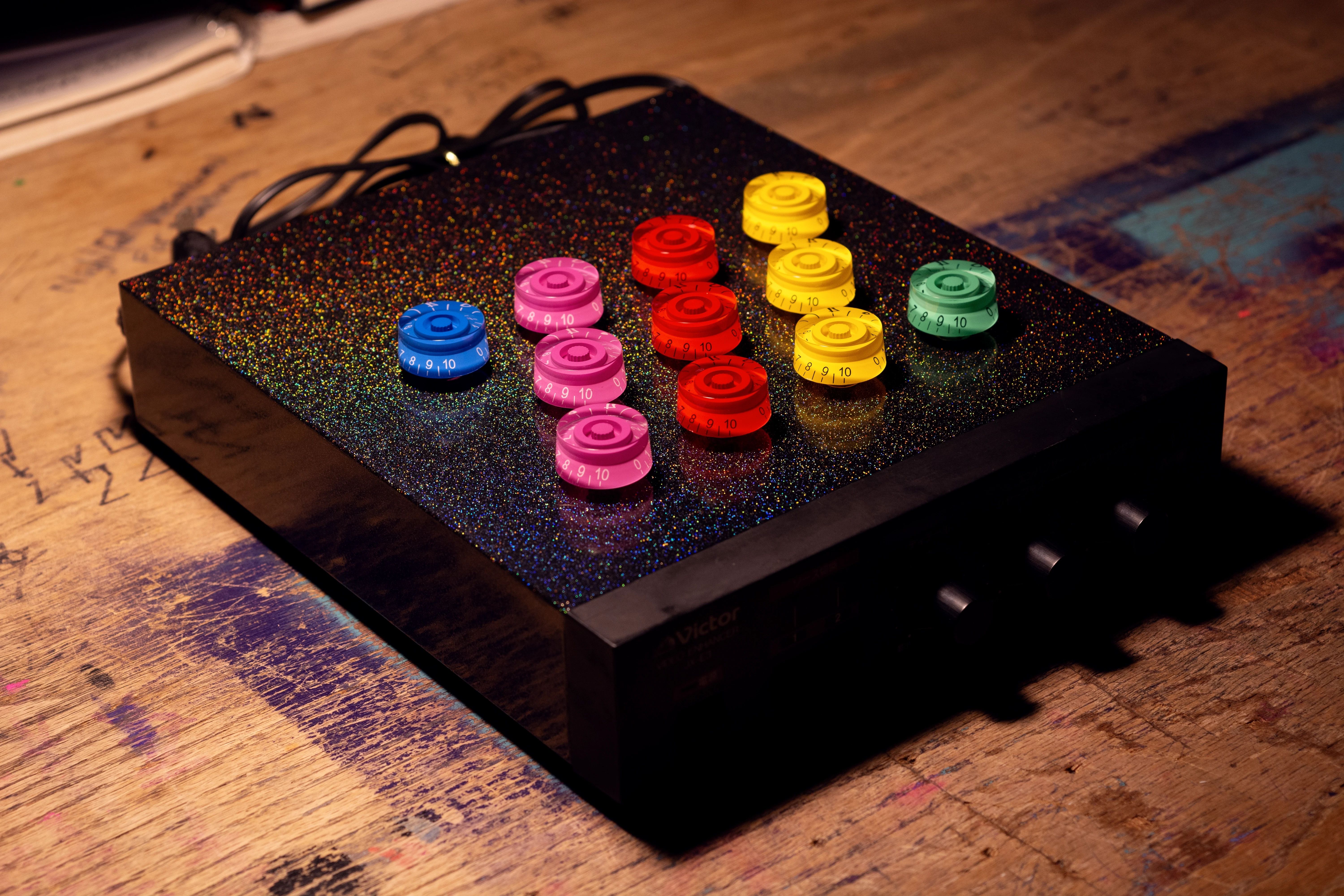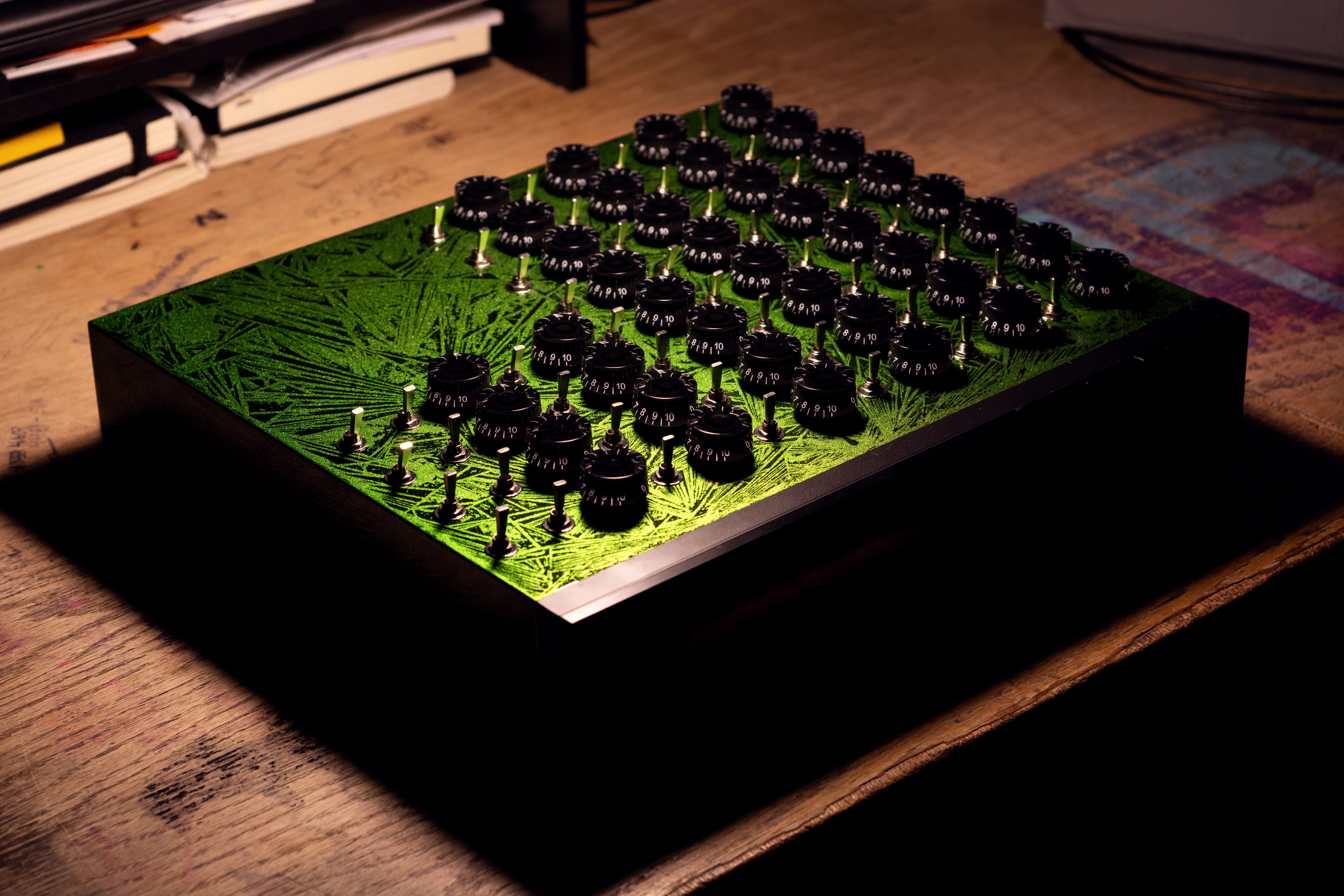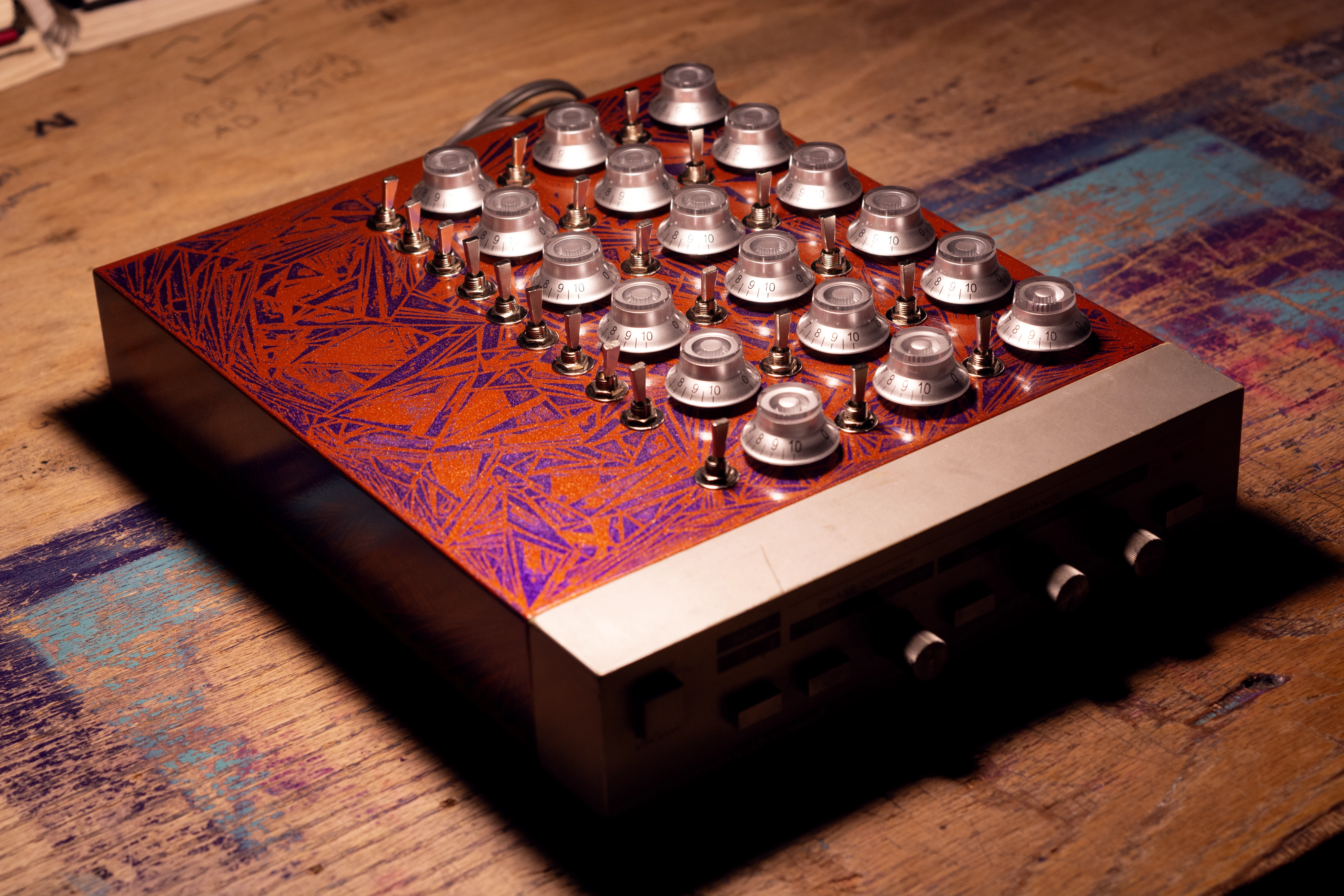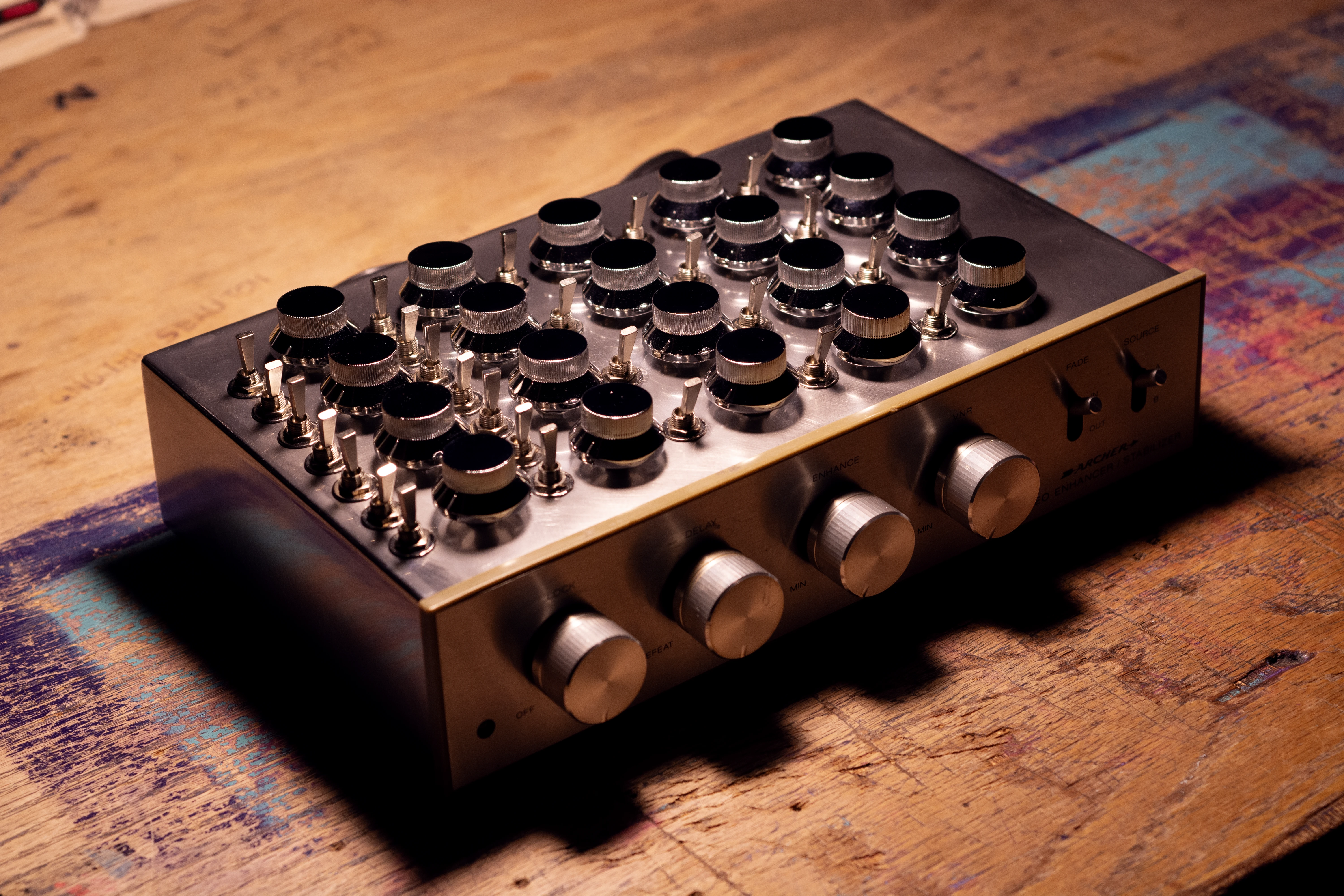Intro
Fermata Positronics is a practise in electronic Kintsugi. The devices upon which I work were originally designed to bring crystal clarity to soft analog video. Within this perfect clarity are hidden buds in stasis, waiting to unfurl into blossoms of great beauty.
In their unmodified state, the circuitry within these devices varies in depth and complexity—some designs are simple and elegant, while others are exceptionally intricate, bordering on magick. Their original designers and engineers had only the aforementioned crystal clarity in mind, but within their work they left behind trails to secret beauty.
When these perfectly balanced rivers of electricity are perturbed and diverted, the original analog video signal’s waveform is distorted and contorted. The newly manipulated waveform is then interpreted by the receiving device (e.g., a CRT monitor), and unintended textures, colours, and patterns reveal themselves.
In this manner, the form and function of the original device is broken. However, a new, shimmering amalgam of energy and light fills the rifts. The once-hidden paths begin to whisper their secrets, and the buds begin to open, revealing themselves in cosmic splendour.
When a prism receives a beam of coherent white light, it refracts the beam, fanning it out into a spectrum of colours—colours previously obscured by the perfect coherence of the original beam. In this sense, these video devices—once modified—perform an alchemical transformation upon the original electric river that flows within them, unravelling it into its component parts in a manner that is both surprising and unpredictable.
Though each Fermata device has been given its own name, this is why I refer to each one as a Video Prism.
While this is a practise in the art of imperfection, it is also a practise that intends to honour the unchanged form and function of the original devices. While transforming them—rather than completely imposing my creative will upon them—I allow the original designs to guide and inform me as to what new forms they would like to take.
There is something particularly wonderful about the austere face and body of video equipment that was designed in the 1980s, and I find it immensely inspiring. Though on the surface they may seem slightly cold and severe, I always detect a certain warmth and love within the original designs, and that warmer—lighter—aspect is what I seek to bring to the surface.
Series I—Fenestra
Series II—Pleiades
FAQ
To gain a clearer understanding of the ordering process and important details about Fermata devices, please read through the following FAQ questions and answers:
⚡️ What is your current price list and device availability?
Series I—Fenestra:
- Dragonfly—$850
- Firefly—$850
- Hither Dither—$350
- Spectraloom—$400
Series II—Pleiades:
- Mach Diamond—$850
- Octarine—$850
- Sugar Glider—$850
- Feather Glider—$550
- Mnemosyne—$550
- Astralathe—$550
- Quicksilver—$600
All prices are in Canadian dollars and do not include shipping costs.
Availability for each device can be found on its individual page. I keep availability status up to date, so if you see something in stock, it is available to order at the present moment.
When you see that a built-to-order device has a number of ‘spots’ available, it indicates how many working base units I have on hand—and therefore how many builds I am currently able to schedule.
⚡️ What is the order process like?
When you are ready to place an order, the process is as follows:
For all built-to-order devices: When you have reached out to me, and confirmed your interest in a device, I will ask for an initial deposit of half the cost of the device. Once I have completed your device, I will then ask for the second payment which consists of the second half of the device's cost, plus the cost of shipping.
For custom Hither Dither & Spectraloom orders the process is similar, but I will ask for the full cost of the device up front, and then the cost of shipping once I have completed your device.
Occasionally, I may have pre-built devices in stock and available for purchase. Orders for in-stock units consist of a single payment, which includes the cost of the device plus shipping.
If I have no base units in stock for a device that you are interested in ordering, and you are on the waitlist, I will reach out to you to confirm if you would like to proceed with your order when I have acquired an operational base unit, and am ready to build your device.
Please send all inquiries to fermata.positronics [at] gmail.com.
⚡️ What is the wait time like?
If I have a supply of base units in stock, the time that it will take for me to complete your device, from the time of your initial deposit, can be up to approximately one month. For efficiency, I schedule builds in monthly batches; the larger a batch of orders, the longer the wait will be.
When you are on the waitlist for a particular device, it can take upwards of a few months for me to source a base unit, if I have run out of stock. All of the units that I build upon are uncommon, and thus their availability is somewhat random, though I consistently search for all of them every day.
⚡️ What forms of payment do you accept?
I accept payment in Canadian dollars via PayPal. If you reside within Canada, I also accept payment via Interac e-Transfer.
⚡️ Where do you currently ship to?
I currently ship to Canada, the United States, United Kingdom and European Union, using Canada Post or UPS. Be aware that the cost to ship a device to the UK or EU is fairly high.
I can potentially ship to locations outside of the aforementioned areas, though the cost to do so may be high. Feel free to send me a message to discuss options.
All devices ship from Ontario, Canada.
⚡️ What are the differences between your devices?
Each of my devices expresses itself uniquely. When you view the demos for each one, you’ll notice that they each tend to hover within a particular set of colour, texture, and pattern characteristics. Sometimes there is overlap at the periphery, but overall, each device offers something distinct.
Although the core principles behind the enhancer and colour correction circuits are similar across all of these units, they are implemented quite differently—modifying and distorting the source signal’s waveform in unique ways. Some are simpler; others are more complex. These variations in circuit design, combined with the way I’ve installed each modification, result in an idiosyncratic palette specific to each machine.
The demos reflect my own creative preferences, but you can often explore further than what I have shown, discovering your own sweet spots as you tweak and combine different knobs. You’ll find that each device is an instrument unto itself—even when they share similarities. Think of it like the differences between a violin, cello, bass, or guitar: while their construction is somewhat similar, they each sound and play differently, and occupy their own distinct place in the mix.
They will also respond differently depending on the kind of source material you feed into them. I encourage experimentation, as one patch’s effect can easily blossom into something new when you try different source material. For instance, a flat, high-contrast animation or image will spawn a different kind of effect than a more dynamic source with subtle gradients of hue and luminance.
A note about the clarity of the bypassed video: With Series I devices, you’ll be able to achieve a relatively clean signal when they are in bypass mode and the effect controls are not engaged. I’ve included a visual of the clean signal in bypass mode in the demos for each device in this series.
In Series II devices, the signal in bypass mode will always be somewhat to heavily affected. Some of the effect controls can help clean up the signal, but with these devices in particular, you’ll be working with a more distorted signal overall. I’ve included a capture of the dry video signal going directly to a CRT in the demos solely for reference. These clean example loops do not reflect the bypass capabilities of the devices in this series.
⚡️ What kinds of case finishes and aesthetic customizations do you offer?
I finish each case with automotive-grade aerosol paint and am happy to work with you to bring your aesthetic preferences to life.
I practise a variety of different layering techniques, including the use of effect coatings (e.g., coloured metal flake and holographic flake), metallics, pearls, candy coatings, and crystal FX—a solution made from urea and distilled water, which grows a crystal mask used between contrasting layers of paint.
I also offer the option to sand and polish the bare metal of the case (usually carbon steel) to a near-mirror finish, which is the default for the Quicksilver. For all other devices, this would require an additional fee.
You can also request your preferred knob colour scheme and choose between different knob types (e.g., coloured speed knobs—sometimes known as barrel knobs—coloured bell knobs—sometimes known as top hat knobs—or metal bell knobs). On the Quicksilver, metal bell knobs are the default option, but they can be requested for my other devices at additional cost.
At the bottom of the page for each of my devices, you’ll see a selection of completed units, which will give you an idea of the kinds of looks I can accomplish. I’m also happy to explore new and different options with you—your ideas and suggestions are more than welcome!
⚡️ Do you upgrade any of the original components to extend the longevity of your devices?
Yes—in each device, I replace all power capacitors with brand-new Nichicon or Rubycon equivalents, and I replace the voltage regulators with contemporary equivalents where possible.
I also apply contact cleaner to each potentiometer to reduce or eliminate any scratchiness that may have developed over time.
⚡️ Can I send in my unmodified unit for you to modify?
Yes. If you have any of the base units that I build upon, I am able to transform it into one of my existing designs.
I can modify both 100V and 120V units, provided that they are NTSC standard devices. The PAL equivalents of a number these units feature a different circuit design, and thus my designs will not work with them.
When you send in your own base unit, I offer a discounted price.
⚡️ Is a step-down transformer necessary to operate Fermata devices?
Most of the time, yes. The majority of my designs use units from Japan, where electronic devices operate at 100V. However, I am sometimes able to source 120V base units from North America. The Quicksilver, on the other hand, always operates at 120V.
If the devices encounter a voltage that is higher than 100V, there is a high risk that the internal electronic components—in particular the power circuit—will be damaged. Thus, a step-down transformer is required to safely operate all Fermata units, and ensure their longevity.
Here is a selection of step-down transformers that I recommend for use in different regions:
⚡️ Which regions will Fermata devices operate within?
All Fermata devices use the NTSC video standard, and will work with any composite video equipment from NTSC regions.
If you reside in a PAL region and do not have NTSC equipment in your setup, you will likely need to have NTSC-to-PAL / PAL-to-NTSC converters on hand for optimal operation.
⚡️ Is a Time Base Corrector necessary to operate Fermata Devices?
It depends on the setup that you are using your device within. If you are sending the device’s video output directly to a CRT, you will find that it operates well, with minimal dropouts.
If you want to record heavily glitched video to VHS, or capture directly using a video capture card, you will find that a Time Base Corrector can help to stabilize the signal, and allow for a cleaner capture. Be aware that using a TBC will alter the colour and texture characteristics of your visuals—sometimes in a subtle manner, and at other times more drastic.
Many composite video mixers also feature a frame synchronizer at the core of their design, and will provide some degree of stabilization. If you want the cleanest possible signal at the end of your signal chain, a dedicated TBC is the way to go.
⚡️ Why do you recommend your devices for studio use only?
The quality and stability of electrical currents at live venues can sometimes be less than optimal, and unwanted ground loops can be created, which could put your device at risk of being damaged. Due to the age of these units (approximately 40~ years old) such damage may be difficult to reverse.
In a residential studio environment, you will likely have a stable, clean supply of electricity with minimal risk to your device. If you are to use your device in a live situation, it is highly recommended that you use a high quality power conditioner, and ensure your setup is properly isolated to prevent ground loops.
In designing these devices, I have prioritized the discovery of precise sweet spots for the user to linger on and explore in fine detail, rather than creating drastic and sudden changes more suited to a high-energy live performance.












